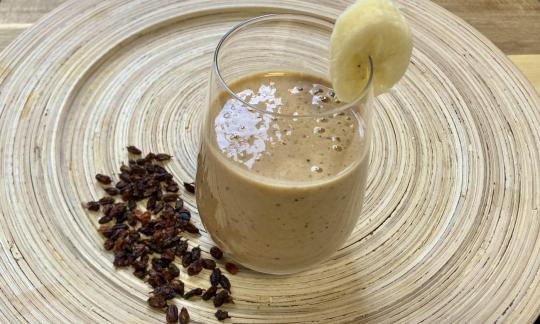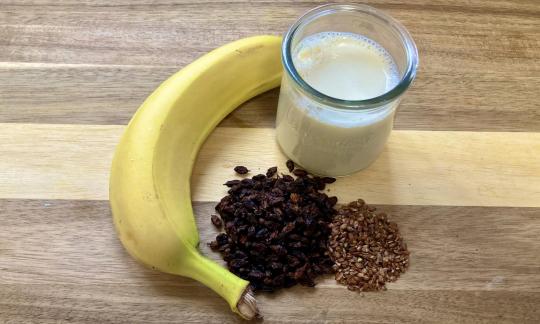Sea buckthorn drink with oat milk and banana
raw-vegan
Ingredients (for servings, )
| ½ oz | Sea buckthorn berries, raw (organic?) |
| 100 ml | Drinking water, raw (organic?) (3.5 oz) |
| 1 | Bananas, raw (organic?) (4.1 oz) |
| 300 ml | Oat milk (oat drink, raw?, organic?) (11 oz) |
| 1 tsp, ground | Linseed, raw, organic? (golden linseed, flax) (0.09 oz) |
Equipment
- blender
- coffee grinder, electric
Type of preparation
- chop or grind
- food preparation without heating
- soak
- purée
Preparation
Preparation
Soak dried sea buckthorn berries (1 teaspoon equals 1 tablespoon of fresh berries) in water for about 30-60 minutes. Grind flax seeds in an electric coffee grinder.Fresh berries: Since it is very difficult to get fresh berries depending on the country, we used dried sea buckthorn berries for the preparation, as shown in the picture. If you use fresh berries, you don't need to soak them at this point.
preparation
Puree the soaked sea buckthorn berries, the soaking water and the banana in a blender for a few minutes. Add the oat milk and linseed and continue mixing.
Serve immediately.Optional: Finally, strain the mixture through a sieve to remove any small seeds.
|
Nutritional Information per person
Convert per 100g
|
2000 kcal | |
|---|---|---|
| Energy | 125 kcal | 6.2% |
| Fat/Lipids | 3.4 g | 4.8% |
| Saturated Fats | 0.44 g | 2.2% |
| Carbohydrates (inc.dietary fiber) | 24 g | 8.9% |
| Sugars | 15 g | 17.0% |
| Fiber | 2.6 g | 10.2% |
| Protein/Albumin | 1.9 g | 3.8% |
| Cooking Salt (Na:81.3 mg) | 206 mg | 8.6% |
| Essential micronutrients with the highest proportions | per person | 2000 kcal | |
|---|---|---|---|
| Vit | Vitamin B3 (Niacin) | 57 mg | 354.0% |
| Vit | Vitamin C (ascorbic acid) | 39 mg | 49.0% |
| Min | Manganese, Mn | 0.68 mg | 34.0% |
| Vit | Vitamin B6 (pyridoxine) | 0.38 mg | 27.0% |
| Fat | Alpha-Linolenic acid; ALA; 18:3 omega-3 | 0.46 g | 23.0% |
| Vit | Vitamin B1 (Thiamine) | 0.19 mg | 17.0% |
| Elem | Potassium, K | 290 mg | 15.0% |
| Fat | Linoleic acid; LA; 18:2 omega-6 | 1.3 g | 13.0% |
| Elem | Magnesium, Mg | 46 mg | 12.0% |
| Elem | Phosphorus, P | 78 mg | 11.0% |
Detailed Nutritional Information per Person for this Recipe
The majority of the nutritional information comes from the USDA (US Department of Agriculture). This means that the information for natural products is often incomplete or only given within broader categories, whereas in most cases products made from these have more complete information displayed.
If we take flaxseed, for example, the important essential amino acid ALA (omega-3) is only included in an overarching category whereas for flaxseed oil ALA is listed specifically. In time, we will be able to change this, but it will require a lot of work. An “i” appears behind ingredients that have been adjusted and an explanation appears when you hover over this symbol.
For Erb Muesli, the original calculations resulted in 48 % of the daily requirement of ALA — but with the correction, we see that the muesli actually covers >100 % of the necessary recommendation for the omega-3 fatty acid ALA. Our goal is to eventually be able to compare the nutritional value of our recipes with those that are used in conventional western lifestyles.
| Essential fatty acids | per person | 2000 kcal |
|---|---|---|
| Alpha-Linolenic acid; ALA; 18:3 omega-3 | 0.46 g | 23.0% |
| Linoleic acid; LA; 18:2 omega-6 | 1.3 g | 13.0% |
| Essential amino acids | per person | 2000 kcal |
|---|---|---|
| Tryptophan (Trp, W) | 0.03 g | 10.0% |
| Threonine (Thr, T, irreversibly transaminated) | 0.06 g | 7.0% |
| Phenylalanine (Phe, F) | 0.09 g | 6.0% |
| Valin (Val, V) | 0.10 g | 6.0% |
| Isoleucine (Ile, I) | 0.07 g | 5.0% |
| Leucine (Leu, L) | 0.13 g | 5.0% |
| Lysine (Lys, K, irreversibly transaminated) | 0.08 g | 4.0% |
| Methionine (Met, M) | 0.02 g | 3.0% |
| Vitamins | per person | 2000 kcal |
|---|---|---|
| Vitamin B3 (Niacin) | 57 mg | 354.0% |
| Vitamin C (ascorbic acid) | 39 mg | 49.0% |
| Vitamin B6 (pyridoxine) | 0.38 mg | 27.0% |
| Vitamin B1 (Thiamine) | 0.19 mg | 17.0% |
| Vitamin K | 8.6 µg | 11.0% |
| Vitamin B7 (Biotin, ex vitamin H) | 5.5 µg | 11.0% |
| Vitamin B9, B11 (Folate, as the active form of folic acid) | 19 µg | 10.0% |
| Vitamin E, as a-TEs | 1.0 mg | 9.0% |
| Vitamin B5 (Pantothenic acid) | 0.37 mg | 6.0% |
| Vitamin B2 (Riboflavin) | 0.06 mg | 4.0% |
| Vitamin A, as RAE | 21 µg | 3.0% |
| Essential macroelements (macronutrients) | per person | 2000 kcal |
|---|---|---|
| Potassium, K | 290 mg | 15.0% |
| Magnesium, Mg | 46 mg | 12.0% |
| Phosphorus, P | 78 mg | 11.0% |
| Sodium, Na | 81 mg | 10.0% |
| Calcium, Ca | 33 mg | 4.0% |
| Essential trace elements (micronutrients) | per person | 2000 kcal |
|---|---|---|
| Manganese, Mn | 0.68 mg | 34.0% |
| Iron, Fe | 1.2 mg | 8.0% |
| Zinc, Zn | 0.76 mg | 8.0% |
| Copper, Cu | 0.08 mg | 8.0% |
| Iod, I (Jod, J) | 5.9 µg | 4.0% |
| Selenium, Se | 0.91 µg | 2.0% |
| Fluorine, F | 38 µg | 1.0% |
The sea buckthorn drink with oat milk and banana tastes delicious and is healthy.
Nutrient profile: According to GDA guidelines, one portion of this drink contains far more than the average daily requirement of niacin, formerly known as vitamin B3. Vitamin C is covered by 50%. The ratio of omega-6 to omega-3 fatty acids is 3:1, which is clearly within the maximum recommended ratio of 5:1. Read more at: Vegans often eat unhealthily. Avoidable nutritional errors.
Sea buckthorn: Unlike the blackthorn, the sea buckthorn belongs to the oleaster family. It is also covered in thorns. It owes its name to the fact that it thrives on sandy ground. The striking red color of the berries has led to sea buckthorn also being called orange berry bush, coral bush or red blackthorn. The berries of the sea buckthorn are used to make jams, cakes and other desserts, as well as juices. The plant is particularly well-known for the high vitamin C content of its fruits. The berries are a traditional remedy that has been used for thousands of years to treat all kinds of ailments.
Bananas: Bananas contain a very well-balanced mix of carbohydrates. As far as trace elements are concerned, bananas are the richest in copper of all known fruits. They also contain more iron than most fruits, are rich in potassium, phosphorus, magnesium and have a relatively high manganese content for a fruit.
Oat milk: Oat milk (EU: oat drink) is made from oats and water. Oat milk is suitable as a cow's milk substitute and is easy to prepare yourself (see "Alternative preparation").
Flaxseed: Flaxseed is the seed of the flax plant (common flax, Linum usitatissimum). Flaxseed has a slightly nutty taste and a fat content of around 40%. With around 50% of the polyunsaturated omega-3 fatty acid alpha-linolenic acid, this has the highest concentration of omega-3 fatty acids of all known vegetable oils. Those who eat a lot of industrial food should increase the amount of flaxseed in their diet and correct any nutritional errors in this regard.
Dried berries: Since it is very difficult to get fresh berries depending on the country, we used dried sea buckthorn berries for the preparation, as shown in the picture. If you use dried berries, you will need to soak them for 30-60 minutes (see step 1). To convert, you can assume that 1 teaspoon of dried berries is equivalent to about 1 tablespoon of fresh berries.
Making oat milk: Information on making your own raw vegan oat milk can be found under the "Make Your Own" section in the following link: Oat milk.
Plant-based drink: Instead of oat milk, you can also use another plant-based drink. Examples include soy milk, hazelnut milk, rice milk and almond milk.






